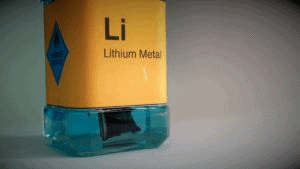Anomalous Properties of Lithium & Beryllium | Chemistry for JEE Main & Advanced PDF Download
Anomalous Behaviour of Lithium
Group 1 elements in the periodic table are the Alkali Metals. The first element of group 1 is lithium. So, why does it behave so differently? Well, the small size of the element is the reason for its anomalous behaviour! Let’s see how.
Nature of the Element
Lithium is extremely electropositive in nature. This is the reason why it can form covalent bonds. The polarization behaviour of its ion somewhat in the same lines as magnesium ion. Therefore, there exists a diagonal relationship between magnesium and lithium. There are a number of reasons why this diagonal relationship exists between them. Let us look at the various reasons below.
As we move from the top to bottom in a group, the electropositive nature of the elements increases. However, when we move from left to right in a period, this nature decreases. It is because of this reason that we observe similarities in the properties between diagonal elements.
We know that the size of the atoms increases from top to bottom in a group. Because of this, the polarizing power of the element decreases. However, when we move from the left to right in a period, this polarizing power keeps on increasing. This is another reason for the diagonal elements to show similar properties. Thus, we see that lithium is a strong element that is quite similar to magnesium.
Their ions have comparable boiling and melting points. Due to its small size, the atom possesses high ionization energy. It reacts with water and liquid bromine. This forms a highly stable hydride unlike most of the other alkali metals. It is interesting to note that magnesium exhibits exactly these similar properties.
Similarities between Lithium and Magnesium
- Lithium and magnesium both form monoxides.
2Mg + O2 → 2MgO - They both react with nitrogen to form their nitrides respectively.
Li(s) + N2(g) → 2Li3N(s) - They both react slowly with water. They form oxides and hydroxides which decompose on heating.
Mg(s) + 2H2O(g) → Mg(OH)2(aq) + H2(g) - Oxides of both the elements do not form super oxides.
- The carbonates of both decompose on heating to form the oxides and carbon-dioxide.
2 Mg(s) + CO2 → 2MgO(s) + C(s) - Lithium chloride (LiCl) and magnesium chloride (MgCl2) are both soluble in ethanol.
- Both the elements are less stable towards heat.
- Differences between Lithium and Other Alkali Metals
Lithium is harder than other alkali metals. - Melting and boiling point is higher than other alkali metals.
- Out of all the other alkali metals, it is the least reactive metal.
- It is a strong reducing agent compared to other alkali metal.
- It is the only alkali metal that forms its monoxide.
- Compared to other alkali metals, it is not capable of forming solid hydrogen carbonates.
- It does not react with ethyne to form ethynide. On the other hand, all other alkali metals form ethynide.
- It reacts slowly with bromine as compared to other alkali metals.
Solved Example
Q. Give some practical applications of lithium.
Solution:
- We use it in the manufacturing of batteries.
- It is used in the glass and ceramic industry.
- It finds its use in the polymers and drug industries as well.
Anomalous behaviour of Beryllium
Beryllium has more covalent nature due to its smallest size, Highest ionization energy, high electropositive nature and strongest polarizing nature. Because of these, Beryllium differs from other alkaline earth metal properties.
- It is the hardest metal among alkaline earth metals.
- Does not react with water even at red hot conditions.
- Melting and boiling point of beryllium is maximum.
- It does not react directly with hydrogen to form hydride.
- Unlike other alkaline earth metals, does not liberate hydrogen from acid because of higher electrode potential. Concentrate nitric acid form a coating of oxide, which makes it passive.
- Beryllium oxide and hydroxide are amphoteric. Dissolves in acids to form salts and in bases to form beryllate.
- Beryllium forms carbide of a different formula and yields methane and not acetylene like other metal on reaction with water.
- Beryllium nitride is volatile.
- It does not react with atmospheric nitrogen and oxygen.
Diagonal Relationship of Beryllium with Aluminium
- Beryllium of group two resembles more with Aluminum of group three:
- Both beryllium and aluminium occur together in the mineral, “Beryl” 3BeO Al2O3 6SiO2 Both of them do not react with atmospheric oxygen and nitrogen.
- Both of them do not react with water even at high temperatures.
- They do not liberate hydrogen from acid. On treatment with concentrated nitric acid, they become passive.
- Both form polyvalent bridged hydrides of covalent nature.
- Halides of both are polyvalent, bridged, and of low melting points. Halides are Lewis acids.
- Water hydrolyzes both nitrides liberate ammonia.
- Oxides and hydroxides of Be and Al are amphoteric. So, they react with acid as well base.
- Both form carbide, that on hydrolysis yields Methane.
- Carbonates of beryllium and Aluminum are unstable.
|
334 videos|656 docs|300 tests
|
FAQs on Anomalous Properties of Lithium & Beryllium - Chemistry for JEE Main & Advanced
| 1. What are the anomalous properties of Lithium and Beryllium? |  |
| 2. How do the anomalous properties of Lithium and Beryllium affect their chemical behavior? |  |
| 3. Why do Lithium and Beryllium exhibit anomalous properties compared to other elements in their respective groups? |  |
| 4. How are the anomalous properties of Lithium and Beryllium important in practical applications? |  |
| 5. Can the anomalous properties of Lithium and Beryllium be explained by their atomic structures? |  |

















